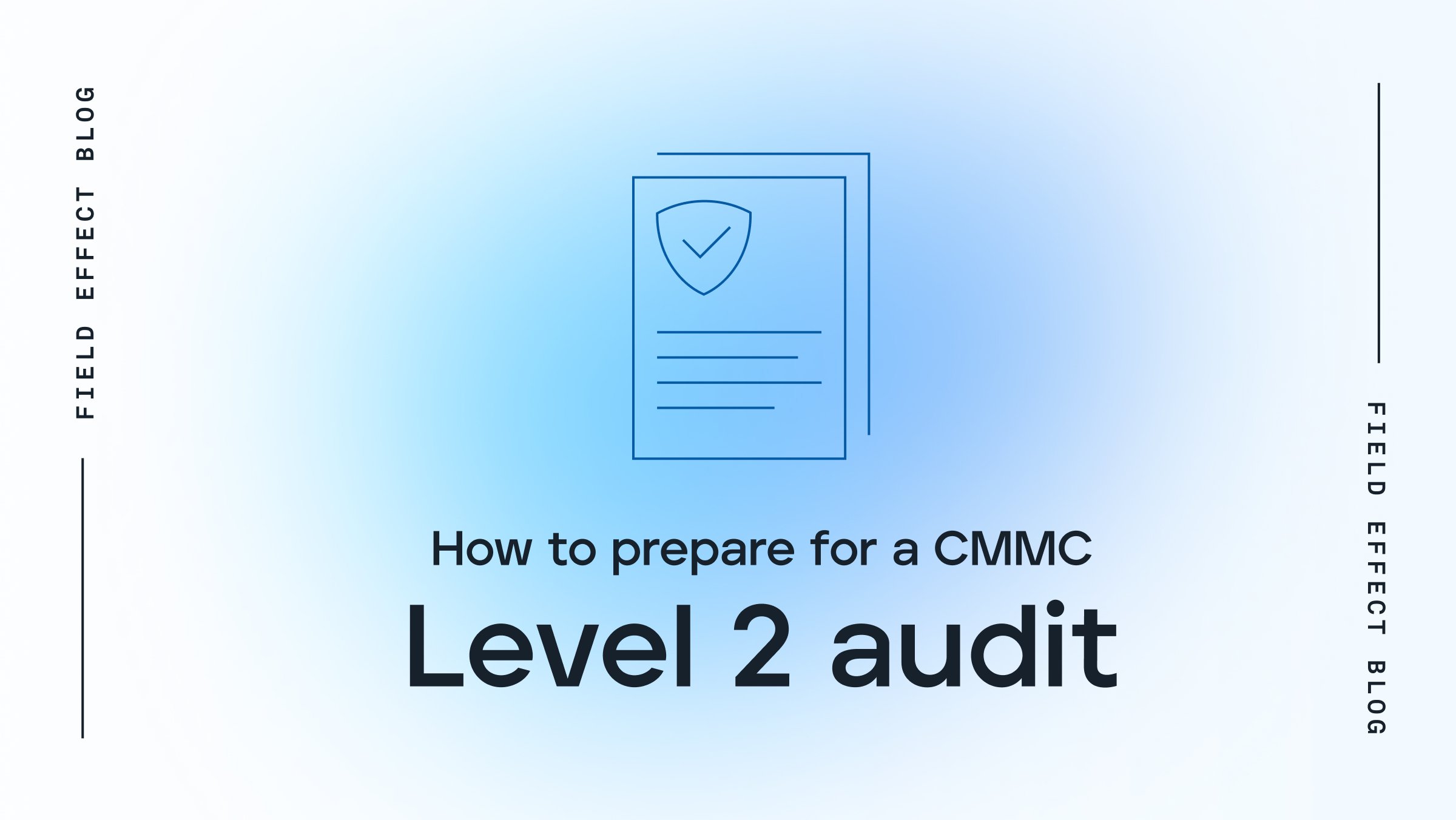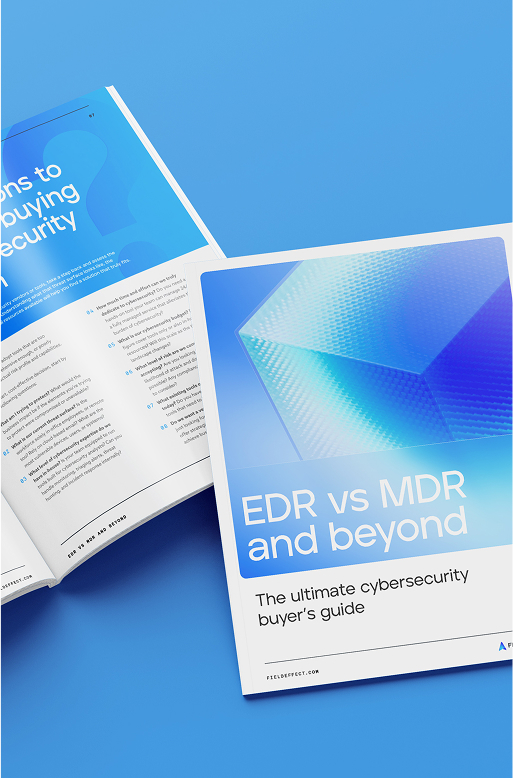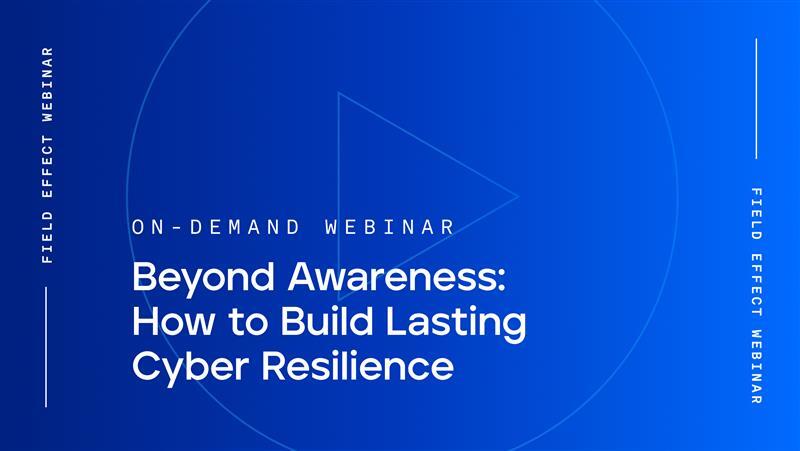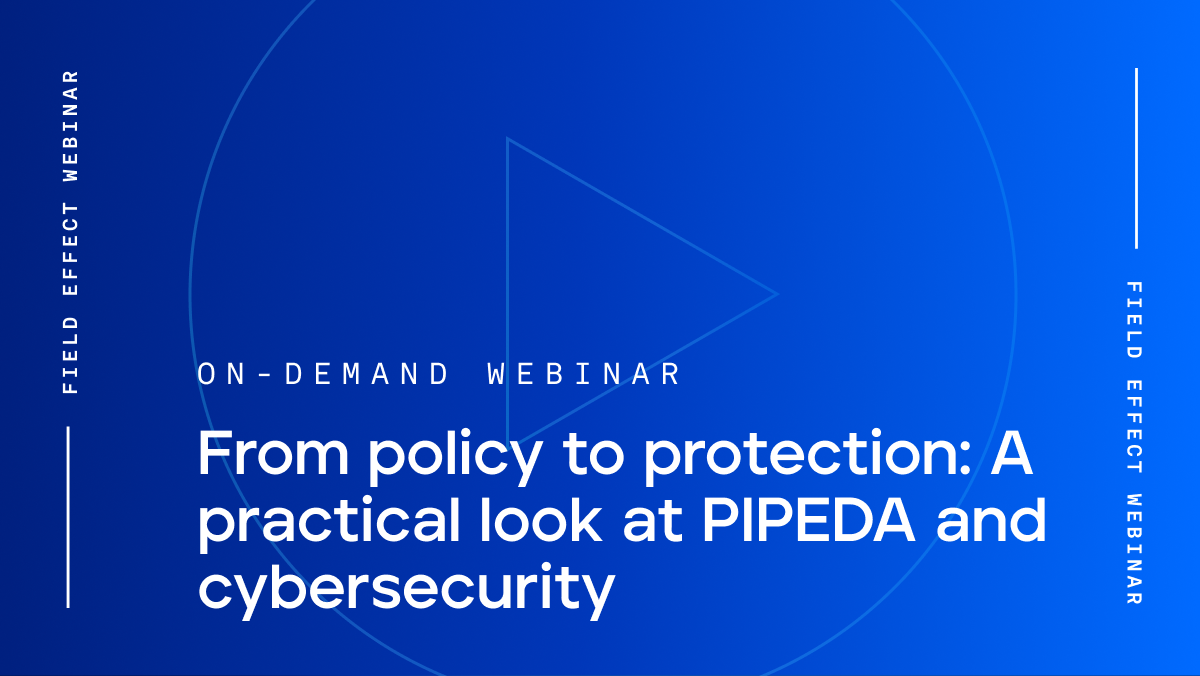
Blog Post
June 16, 2025 | Cybersecurity education
By Field Effect
Last updated: November 13, 2025
The cybersecurity world can sometimes feel like a tangled web of acronyms, each longer and more complex than the last. We've previously covered some of the more common terms, but today, let's dive deeper into the world of detection and response, focusing on three heavy hitters:
These three detection and response solutions are hot topics in the security sector and dominate a lot of conversations. And it's no wonder why: MDR, XDR, and EDR share a lot of DNA.
Although they are closely related, significant differences and subtle nuances set them apart. Without understanding each approach's specific outcomes, businesses may find it challenging to choose the right solutions to safeguard their operations and data effectively.

EDR vs MDR and beyond
Make sure you're making a smart buying decision with this ultimate guide.
You'll learn how EDR and MDR compare, plus strategic questions to vet vendors and their solutions.
Let’s take a closer look at MDR, XDR, and EDR to better understand their capabilities and potential benefits.
In this blog, you’ll learn:
| MDR | XDR | EDR | |
| Capabilities |
|
|
|
| Coverage |
|
|
|
| Benefits |
|
|
|
| Limitations |
|
|
|
Endpoint detection and response (EDR) tools excel at monitoring activity on endpoints and flagging suspicious behavior. By continuously collecting and analyzing data from devices, EDRs help detect and contain threats before they escalate.
Specifically, EDR tools provide:
EDR offers a number of benefits that make it an attractive tool for bolstering cybersecurity. It provides valuable visibility into activity on your endpoints—a critical feature knowing that 70% of all breaches start with endpoints.
Organizations with fully staffed security operations centers (SOCs) can see significant value from EDR. But for teams without dedicated security expertise, EDR often creates more challenges than clarity:
Ultimately, while EDR provides critical capabilities, it requires significant time, tuning, and expertise to see real value.
Threats can slip by if alerts are overlooked, misinterpreted, or addressed too slowly—which is often the case without an experienced team in place to manage the volume (and complexity) of alerts.
XDR’s origins come from the fact that looking through a single lens at an organization’s infrastructure simply doesn’t provide the coverage and visibility required to minimize the threat surface. Threats can originate not only from endpoints but also from networks, clouds, and even employees themselves.
Traditional cybersecurity solutions are often seen as limited, focusing on only one aspect of a threat surface. XDR addresses these limitations by integrating detection and response capabilities across many areas across the threat surface, all into one unified platform. Often available as software-as-a-service (SaaS), XDR simplifies access to these advanced technologies for businesses.
In today’s world of hybrid work environments, complex IT infrastructures, and increasingly sophisticated threats, XDR solutions strive to deliver relevant information and threat data. This helps organizations better protect their data and operations, providing a more holistic approach to cybersecurity.
XDR solutions recognize that endpoint detection alone isn't sufficient to safeguard modern IT infrastructure. Indicators of compromise don't appear only at endpoints; they can also be revealed through abnormal network traffic patterns and unusual cloud activities.
XDR offers a range of benefits for organizations:
XDR takes its broad approach to cyber threat monitoring by pulling together multiple pieces of technology to deliver greater insight into an IT environment.
That said, even this approach has its drawbacks.
XDR solutions are often constructed from various components that weren't developed cohesively, leading to integration issues. Each part of the platform might only offer a partial view of the overall picture. Additionally, the combination of different technologies requires a full team to staff.
This complexity can also generate significant noise, with each tool in an XDR solution potentially issuing multiple alerts for the same issue. Suspicious activity in a cloud service might be related to an endpoint alert, but XDR solutions don't always provide that context—potentially making the difference between preventing an attack or falling victim to one.
As helpful as EDR and XDR can be for an organization, they come with their own sets of challenges. These tools generate vast amounts of activity data—whether from endpoints or other areas of your IT infrastructure—which requires further analysis. This increases workloads and demands a deep understanding of cybersecurity telemetry and processes.
This is where managed detection and response (MDR) comes into play.
MDR addresses a core cybersecurity challenge: limited in-house expertise and resources. By combining technology with 24/7 access to security professionals, MDR offers advanced threat detection, real-time response, and continuous protection—all while operating as an extension of your team.
As we’ve touched on, EDR and XDR generate significant amounts of information, requiring teams to parse greater volumes of alert data and determine what is a false positive and what is an actual threat. MDR takes this responsibility off a client's shoulders, placing detection and response duties in the hands of experienced third-party security providers.
Core features of MDR solutions include:
As demand has grown, MDR has expanded beyond endpoint protection to include cloud, network, and vulnerability management. This evolution helps organizations simplify operations and unify their security under a single service, simplifying management and strengthening their overall security posture.
As is often the case, MDR offerings can vary significantly in cost, scope, and effectiveness. Some providers emphasize outcomes but lack the depth or responsiveness needed when it counts. Some providers use their own security platform; others integrate with the tools already in place. That’s why it’s critical to evaluate not just the technology, but the team, expertise, and service behind it.
For the purpose of this guide, we'll split MDR offerings into three categories: basic MDR, managed EDR, and sophisticated MDR.
These MDR solutions, which integrate with third-party technologies, are a great option for those with existing tech stacks they can’t easily replace. These solutions enhance cybersecurity posture without disrupting current infrastructure, making them especially valuable for businesses seeking expert security management without a full overhaul.
By centralizing the management of various security tools, integrated MDRs unlock greater return on existing investments. They introduce advanced threat hunting capabilities—including behavioral analytics and AI-powered threat detection—that identify even subtle threats in real-time.
But integration has its tradeoffs:
Managed EDR solutions bring powerful endpoint protection and expert oversight together under one vendor, offering organizations a streamlined path to better security. These tools offload the burden of triaging and responding to alerts, empowering internal teams to focus on high-priority incidents that demand their attention.
This approach is valuable for those without a mature cybersecurity program as it delivers essential features, such as real-time threat detection, response, and threat intelligence, to defend against evolving endpoint threats.
However, like any solution focused solely on one threat surface, areas like the cloud and network are left unsecured. When used alongside separate tools, managed EDR can limit threat context and make it harder to connect the dots across environments.
This solution provides 24/7 SOC services integrated with the provider’s own technology stack—which can extend protection across endpoint, cloud, and network. This unified approach delivers enhanced visibility and cross-environment analysis for better security outcomes, all while eliminating the complexity of juggling multiple vendors.
With full ownership of the stack, the MDR provider gains deep insight into detection logic, telemetry, and system performance. That means faster, more accurate threat detection—and the agility to continuously optimize protection across the entire environment.
This type of solution is especially valuable for organizations seeking a comprehensive and unified defense, or wishing to rapidly improve their security capabilities. However, those with existing investments must decide whether to fully transition or run this solution concurrently.
The cybersecurity market is crowded, with every vendor claiming the latest breakthrough or essential feature. But buying cybersecurity is more than ticking off features. It’s about investing in outcomes: less risk, less complexity, fewer interruptions, and more confidence.
So, the question is less “what’s available?” and more “what do I need?”
Not all solutions are built the same. Even within the same category, vendor capabilities can vary widely, leaving critical gaps if you don’t dig deeper.
Here are some questions to ask to measure a vendor's maturity:
What management capabilities are included in your solution, and what will that cost you? Some providers bundle essential services into their offering; others tack on fees for what should be standard.
Ask the right questions to know what you're really getting:
Cyber threats rarely operate in isolation. A suspicious login to an email account may be connected to an infected endpoint or a compromised cloud service. Without cross-environment analysis, these signals might be missed.
Single-pane-of-glass visibility refers to a unified view of data, systems, and security across an organization through a single dashboard or interface. This results in:
More generally, this allows organizations to see and respond to what’s happening across endpoints, cloud, and network from one place.
A good cybersecurity solution won’t slow teams down; it will empower them to act fast.
For the many organizations short-staffed in the security department, that may mean explaining exactly what to do with prioritized alerts and simple remediation instructions. Even better, a provider that actively responds on your behalf.
Whichever cybersecurity solution you choose, ensure that it:
The lowest price isn’t always the best investment. A cheaper tool can quickly become more expensive when you factor in what it doesn't cover. Consider the hidden costs:
A truly integrated, managed solution reduces both overhead and risk, delivering stronger protection and better outcomes without the hidden drain on resources.
Not sure where to start? Field Effect is here to help. Learn more about Field Effect MDR, our managed detection and response solution, to see what a holistic approach to cybersecurity would look like for your business.


